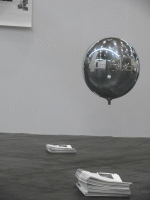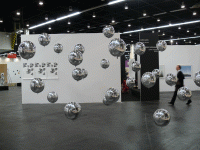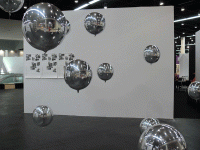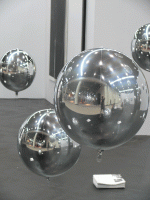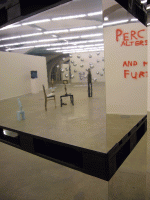Balloons / '“Your very own words.“ Indeed! And who are you?' (Brion Gysin)
Open Space, Art Cologne, 2010
Project with Antje Wachs Gallery, Berlin
.
.
---scroll down for english version---
.
.
.
Katrin Mayers für den Open Space der Art Cologne entworfene Installation eröffnet von zwei in einem rechten Winkel zu einander stehenden Flächen einen Raum, der erst einmal einen scheinbar „neutralen Genuss am Sehen“_1 anspricht.
Auf 5qm Bodenfläche schweben silberne, verspiegelte Ballone in unterschiedlichen Höhen, die mit Nylonfäden am Fußboden befestigt sind. Daneben dient eine Wand, die raumoffen die verschiedenen Ausstellungsflächen voneinander trennt, als Träger eines Plakats. Dieses liegt zudem gefalzt zum Take-away aus und zeigt in fein abgestimmter Anordnung sechs Bildensembles, die über die gesamte Fläche eine assoziative Bilderzählung entfalten. Auf den Abbildungen sind Personen zu sehen, deren Ausdruck zwischen Besinnung und Ekstase, zwischen Träumerei und Selbstbeobachtung, zwischen Innen und Außen oszilliert. Der aufgeführte Index ordnet ihnen Zusammenhänge der Selbsterfahrung, des Rausches sowie deren künstlerischer wie medialer Aufarbeitung zu.
Das Moment der Selbstbeobachtung stellt dabei ein Verbindendes zwischen den beiden Elementen der Installation her. Sowohl in den Balloons mit ihrer spiegelnden Oberfläche und ihrem schwebenden Zustand, die in dieser Darstellung weniger einen erlebbaren Raum bilden als vielmehr eine Reflektionsfläche darstellen, wie auch in den Bilderzählungen werden Paradoxien der Introspektion zwischen Subjekt und Objekt, Vertrauen und Verdacht, Spiegelung und Illusion aufgenommen. Die Abfolge vom Ansehen über ein Betrachten und Sinnen hin zum Verknüpfen findet in der Installation eine räumliche Anwendung.
Fortführen ließe sich dieser Strang auch mit den variantenreichen Lesarten von Andy Warhols Silver Clouds (1966). Immer wieder werden hier Bezüge zu Warhols Persona gezogen, seinen Masken und Darstellungen, dem nicht Fixierbaren und Flüchtigen, sowie dem Reiz des Eskapistischen und Auflösenden.
Katrin Mayers Arbeiten zeichnen sich besonders durch ein präzises Verweben visueller Texturen und materialimmanenter Oberflächen mit räumlichen wie zeitlichen Kontexten aus. Entsprechend ihrer grundsätzlichen Annahme, dass es eben keinen neutralen Ausstellungsraum, sondern immer nur einen zu verhandelnden gibt, nimmt sie die spezifische Situation vor Ort auf - den eben nicht „White“, sondern „Open“ Space der Kunstmesse. Mehr als einen Sinn ergibt im Kontext ihrer Arbeitsweise dabei eine von den Silver Clouds gezogene Linie zu Marcel Duchamps Installation für die Exposition Internationale du Surréalisme (1938) in der Galérie des Beaux-Arts in Paris: beauftragt mit der Gestaltung der Ausstellungsräume wählte er eine Präsentationsform, die in spielerischer Form auf Waren- und insbesondere Schaufensterpräsentation verwies. Zuvor schon hatte Duchamp bei seiner Auseinandersetzung mit Formen und Bedingungen des Ausstellens Elemente von Dekorationen eingebunden, ganz konkret in seiner Gestaltung eines Schaufensters für die Schrift La Part du Diable (1943) von Denis de Rougemont in New York.
In Katrin Mayers künstlerischer Arbeit, im Aneignen und Zusammenführen alltäglicher und ephemerer Materialien wird das Display über sein Mittel hinaus als Methode und Resultat begriffen.
Exemplarisch ist dabei etwas, das nur auf den ersten Blick widersprüchlich klingt: eine die unmittelbare Wahrnehmung adressierende Form, deren Grundlage und Fokus das Diskursive ist. Katrin Mayers Praxis ist eine, die in einer „raumgreifenden kritischen ästhetischen Terminologie“_2 das Dekorative und den Diskurs gemeinsam aufführt und damit auch einen Diskurs des Dekorativen zur Sprache bringt.
Joerg Franzbecker
.
.
1_Dan Flavin, zitiert nach: Hanne Loreck: "VorWAND. Ein kunstkritisches Plädoyer für das Dekorative". In: Bettina Allamoda (Hg.): model map. Zur Kartografie einer Architektur am Beispiel des Hauses des Lehrers Berlin. Frankfurt am Main 2003, S. 116, URL: http://ask23.hfbk-hamburg.de/draft/archiv/hs_publikationen/vorwand.html
2_Vgl. Loreck (wie Anm. 1)
.
.
.
.
-----------------
At first glance Katrin Mayer’s installation addresses the supposedly “neutral pleasure of seeing”_1 in the Open Space at the Art Cologne.
Above the 5 square meters of floor space, balloons with reflective coating float at varying heights, fastened to the floor with nylon strings. On the adjacent wall dividing the open space into various exhibition areas is a placard, also available folded for the taking, that features six groups of pictures assembled in carefully chosen composition, their pictorial narrative unfolding across the breadth of the paper by means of associatively implied connotations. The expressions of the people in the pictures oscillate between contemplation and ecstasy, reverie and introspection, the internal and the external. The accompanying index draws specific correlations between them, interrelationships having to do with consciousness, ecstasy and ways these themes are processed, artistically and within various media.
The temporal moment of introspection is the connecting thread between the dual elements of this installation. The Balloons, with their reflective surface and floating state – not so much creating a space that is able to be experienced as offering a space for reflection – and the pictorial narrative both take up the various paradoxes of introspection, juxtaposing subject and object, trust and suspicion, reflection and illusion. This installation presents the spatial equivalent of a progression from image through examination and reflection to the formation and establishment of connections.
This same thread is carried further with the multifaceted interpretative variations on Andy Warhol’s Silver Clouds (1966), which contain multiple references to Warhol’s persona – references to his masks and his illustrations, to the elusive and the fleeting, to the allure of escapism and the disintegrative.
Mayer’s works are particularly characterized by a precise intertwining of visual textures and materially immanent surfaces on the one hand within spatial and time-based contexts on the other. In correspondence with her basic assumption that, rather than being a neutral space, an exhibition space calls for negotiation, Mayer has designed the installation specifically for its respective venue at the Kunstmesse, a space “open” rather than “white.” With regard to her artistic practise there is more than one way to make sense of a line drawn from the Silver Clouds to Marcel Duchamp’s installation for the Exposition Internationale du Surréalisme (1938) in the Galérie des Beaux-Arts in Paris; commissioned to create an exhibition space, Duchamp chose a form of presentation making playful reference to the display of goods for sale, notably within shop windows. Duchamp had already previously integrated elements of decoration into his examination of the forms and constraints of exhibitions – one example being his creation of a shop window display in New York for Denis de Rougemont’s La Part du Diable (1943).
In its appropriation and aggregation of materials both daily and ephemeral, Mayer’s artistic work goes beyond its respective means to conceive of the concept of “display” as both a method and a result. The form she uses is exemplary in that it addresses intuitive perception based and focused on the discursive – something that sounds contradictory, but only upon first hearing. In her artistic practices, Mayer presents the decorative and the discursive together in a “voluminously all-encompassing critical aesthetic terminology,”_2 thereby bringing about a discourse on and of the decorative.
Joerg Franzbecker
.
.
1_Dan Flavin, citation from Hanne Loreck: "VorWAND. Ein kunstkritisches Plädoyer für das Dekorative." In: Bettina Allamoda (Ed.): model map: Zur Kartografie einer Architektur am Beispiel des Hauses des Lehrers Berlin. Frankfurt am Main 2003, p. 116, URL: http://ask23.hfbk-hamburg.de/draft/archiv/hs_publikationen/vorwand.html
2_Cp. Loreck (as in footnote 1)
.
.
.
and in the exhibition
The End of the World as We Know It /
La Fin du Monde tel que nous le connaissons
curated by Bettina Steinbrügge
Kunsthalle Mulhouse
16.09 - 14.11.2010
Artists:
Marc Bijl ¦ Claire Fontaine ¦ Cyprien Gaillard ¦ Piero Golia,
Hadley+Maxwell ¦ Jorge Macchi ¦ Bernhard Martin,
Katrin Mayer ¦ Mladen Miljanovic ¦ Frédéric Moser & Philippe Schwinger
In 1987 REM recorded the song: “It’s the End of the World as We Know it (and I feel fine). The song originated from a previous, unreleased, R.E.M. song called "PSA", which is short for "Public Service Announcement". The accompanying video depicts a young skateboarder rifling through an abandoned, collapsing farmhouse and displaying the relics that he finds to the camera. This REM song is one of these that were addressing incredible social concerns of the time. But with its appendix “(and I feel fine)” it also showed a positive attitude towards the future. This can be found in contemporary art practice as well. What art history and theory describe as “détournement” signifies the complex practice of dismantling existing aesthetic structures and reassembling them in an altered and subverted way in order to question or critique society, traditional values, and the status quo. All art, in some ways, conveys a vision for the future. Be it, in earlier times Brueghel’s “Ikarus”, Picasso’s “Guernica” or Yoko Ono’s “Instruction Pieces”, pieces of art point visions of future out, sometimes hidden and reflected. In this understanding, artists are challenging the Zeitgeist, and at the same time, contributing to its permanent renewal.
Years after the publishing of the REM song, in 1999, the American Sociologist Immanuel Wallerstein published a text called “The End of the World as we know it”. Wallerstein divides this text between an appraisal of significant recent events and a study of the shifts in thought influenced by those events. “The End of the World As We Know It” concludes with a crucial analysis of the momentous intellectual challenges to society as we know it and suggests possible responses to them." According to Wallerstein, we live in a post-capitalistic society, in the age of passage. Structures are going to disappear and the new is not yet at the horizon. This notion implies a certain chaos that holds the historical chance for social influence. His view should be rallied to as a point of departure rather than dismissed as a dead end. What kind of future do we really envisage? How can we design a topography of this passage? How can we record a peculiarity of this process?
J.J. Charlesworth wrote in a recent issue of ArtsReview that “Now that the initial drama of the financial crash has passed, we’re into a much weirder moment where everyone is trying to maintain some working notion of normality, even so it’s becoming obvious that these are not longer normal times. Carrying on making, showing and writing about even serious art, without some acknowledgement that the society art operates in has completely lost the plot, starts to seem slightly futile. So what to do?” Jacques Rancière claims “a new form of political subjectivity that would accept the point that we start from equality, from the idea that there is a universal competence – that there is a universal capacity that is involved in all those experiments and that we are trying to expand – to expand the field and the capacities of that competence.” Like Wallerstein, he sees us in a kind of interval, in a time without a goal. And he poses the question: “What do we think we are able to do together?” And actually, what does emancipation has to do with that?
This exhibition claims the contemporaneousness of artistic production and believes in the immediate relevance of artistic production for the present. I would like to invite artists and artists groups that take a position: From the financial crisis, the decline of the welfare systems or the fetishistic visual industries to new hopes, utopias and alternative conceptions of common society. Like a seismograph, the exhibition will filter the signs and images of our current life while undermining the governmental power and providing new aesthetic contexts. The exhibition features contemporary works by international artists comprising critical, satirical and subjective responses to the realities of today showing their own personal formulas to express the realities of contemporary life and to offer a means of negotiating a path through it. The concept follows the desire to critically comprehend the current social, political and economic processes in a global world, without which contemporary art couldn’t be reviewed and understood. Especially in times of passage, it is important to look at the art that has enough utopian potential to go beyond traditional and social barriers.
Bettina Steinbrügge
.
.
Fotos: Katrin Mayer and Alisa Ehlert (Antje Wachs Gallery)
